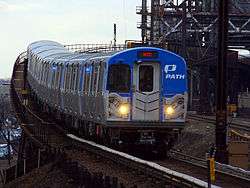Mass transit in the United States
Mass transportation systems in the United States include buses, trolleybuses (or "trackless trolleys"), trams (or "streetcars"), ferries, and a variety of trains, including rapid transit (known as metros, subways, undergrounds, etc.), light rail, and commuter rail. Intercity public transport is dominated by airlines and intercity rail.
Usage

The number of miles traveled by vehicles in the United States fell by 3.6% in 2008, while the number of trips taken on mass transit increased by 4.0%. At least part of the drop in urban driving can be explained by the 4% increase in the use of public transportation [1]
About one in every three users of mass transit in the United States and two-thirds of the nation's rail riders live in New York City and its suburbs.[2][3]
Some railroads, such as the Long Island Rail Road in earlier times, maintained a separate fleet of specially configured electric railway cars to provide a rapid transit service on designated routes that was distinct from its regular passenger operations.
Cities
Most medium-sized cities have some form of local public transportation, usually a network of fixed bus routes. Larger cities often have metro rail systems (also known as heavy rail in the U.S.) and/or light rail systems for high-capacity passenger service within the urban area, and commuter rail to serve the surrounding metropolitan area. These include:
Funding
American mass transit is funded by a combination of local, state, and federal agencies. At the federal level, the Federal Transit Administration (FTA) provides financial assistance and technical assistance to state governments and local transit providers. From FY 2005 to FY 2009, the funding scheme for the FTA was regulated by the SAFETEA-LU bill, which appropriated $286.4 billion in guaranteed funding.[4] The FTA awards grants through several programs, such as the New Starts program and Transit Investments for Greenhouse Gas and Energy Reduction (TIGGER) program.
Legislation
On June 26, 2008, the House passed the Saving Energy Through Public Transportation Act (H.R. 6052),[5] which gives grants to mass transit authorities to lower fares for commuters pinched at the pump and expand transit services. The bill also:
- Requires that all Federal agencies offer their employees transit pass transportation fringe benefits. Federal agencies within the National Capital Region have successful transit pass benefits programs.
- Increases the Federal cost-share of grants for construction of additional parking facilities at the end of subway lines from 80 to 100 percent to cover an increase in the number of people taking mass transit.
- Creates a pilot program for vanpool demonstration projects in urban and rural areas.
- Increases federal help for local governments to purchase alternative fuel buses, locomotives and ferries from 90 to 100 percent.
Advanced public transportation systems
Advanced public transportation systems (or APTS) is an Intelligent Vehicle Highway Systems, or IVHS, technology that is designed to improve transit services through advanced vehicle operations, communications, customer service, energy efficiency, air pollution reduction and market development.
See also
- Paratransit
- Rail transport in the United States
- Light rail in the United States
- High-speed rail in the United States
- Transportation in the United States
- Great American streetcar scandal
- List of bus transit systems in the United States
References
- ↑ http://apps1.eere.energy.gov/news/news_detail.cfm/news_id=12283
- ↑ "The MTA Network: Public Transportation for the New York Region". Metropolitan Transportation Authority. Retrieved 2006-05-17.
- ↑ Pisarski, Alan (October 16, 2006). "Commuting in America III: Commuting Facts" (PDF). Transportation Research Board. Retrieved 2007-03-27.
- ↑ SAFETEA-LU Implementation, Federal Transit Administration.
- ↑ http://speaker.gov/issues?id=0031#13
Further reading
- Cheape, Charles W., Moving the masses: urban public transit in New York, Boston, and Philadelphia, 1880-1912, Harvard University Press, 1980. ISBN 0-674-58827-4























.jpg)
.jpg)
